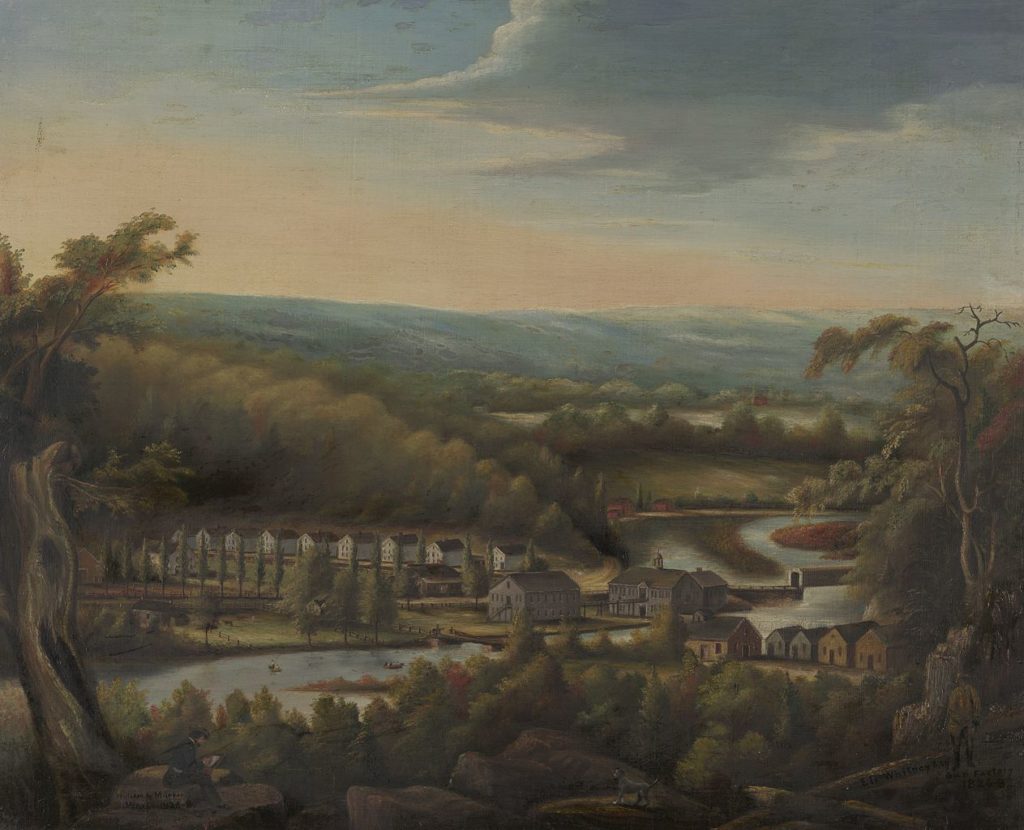By Walter W. Woodward
(c) Connecticut Explored Inc. Summer 2021
Subscribe/Buy the Issue!
In the late 18th and early 19th centuries a perfect storm of problems caused Connecticut to pivot away from its agricultural and mercantile past toward an industrial future. The result, found just about anywhere along the state’s rivers and streams where falling water could power machinery, was the creation of a new form of community: the factory village, often designated with the suffix “-ville.”
According to Ellsworth S. Grant in Yankee Dreamers and Doers (Pequot Press, 1974), between 1790 and 1860 Connecticut saw the creation of around 200 “-villes.” These work-centered communities were built around production, and designed to meet all the needs of the workers and families who made that production possible.
The factory village arose in response to Connecticut crises. Two centuries of farming exhausted soils, coupled with the final throes of the Little Ice Age (1450 – 1850), prompted massive out-migration to the new states in the West. International conflict between Britain and France and the consequent United States Embargo of 1808 closed Connecticut’s ports and paralyzed a once thriving coastal trade. The ensuing War of 1812 only exacerbated the economic crisis. The time called for innovative ideas.
Eli Whitney––the inventor of the cotton gin (in 1794, which fueled plantation slavery across the South and textile manufacturing throughout the North)––had such an innovative idea. Whitney had secured a contract to produce 10,000 muskets for the United States using mass-produced interchangeable parts, and he built America’s first factory village, according to Grant, to do so, Whitneyville, along the Mill River in Hamden beginning in 1798. In addition to a main manufactory and supporting structures, Whitney built houses for workers with families and a boarding house for the single men, plus a store to keep them supplied. For people accustomed to associating industrialization with what the poet William Blake called “England’s dark satanic mills,” Whitneyville modeled a new kind of industrialization, simultaneously innovative and humane.
Other Connecticans further developed the concept. David Humphreys of Derby, Revolutionary War aide to General George Washington, America’s first minister to Spain, and the man who imported merino sheep to New England, set out to make Humphreysville (in Seymour), his wool-manufacturing village, a model of both industrial innovation and enlightened and humane employment practices. Not only were employees (primarily women and children) relatively well paid, they were also well housed (with gardens behind the factory), educated, and even taught religion, morals, and manners.
For Humphreys, as for many of the paternalistic “-ville” founders, creating communities whose treatment of employees contrasted sharply with the darker models of European industrialization was an imperative. Samuel Collins, whose axe factory at Collinsville (in Canton) came to supply high-quality edge-tools throughout North America and South America, wrote (as quoted by Grant), “I would rather not make one cent than to have men go away from here worse than they came.” But not all factory village creators shared such high aspirations, and even among those who did, working hours were long, by today’s standards, and the work often extremely hazardous.
Almost all of Connecticut’s factory villages were named after the entrepreneurs who created them, though two—Augurville (also in Hamden) and Fluteville (in Litchfield)—were named for what they made. Almost all were also created during the first wave of America’s industrial revolution. Collectively, they signified the transformation of Connecticut from an agrarian society into an industrial power that would become a manufacturing colossus before 1900. During that transformation, the factory village would be superseded by the industrial city, and some of the old “-villes,” including Humphreysville, would be erased by the larger entities they helped create.
The presence of the factory village in Connecticut, however, remains strong. Though 66 of the 203 have disappeared, and only two, Montville and Plainville, have matured into towns, 33 “-villes” still have post offices, and 102 “-villes” still mark neighborhoods or boroughs that reflect a pivotal moment in the history of their town, state, and country.
Walter Woodward is the Connecticut state historian. Listen to his podcasts at Gratingthenutmeg.libsyn.com and visit todayincthistory.com.
Go to Next Story
GO BACK TO SUMMER 2021

